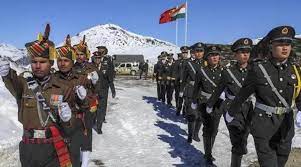Though three years have elapsed since the Galwan clashes occurred in 2020, there are no signs of a thaw in ties between India and China. Several rounds of military and diplomatic level talks have so far taken place, but there has been no headway in terms of resolving the military stand-off which has now entered the fourth year. It goes without saying that the border dispute between India and China has brought ties to the lowest point in six decades.
Three years ago, as many as 20 Indian Army personnel laid down their lives in violent clashes with Chinese PLA troops along the Line of Actual Control (LAC) in Ladakh. Apart from making efforts to resolve the impasse at the military level, India spared no effort to find a way out of the deadlock through diplomatic channels as well. India mounted immense pressure on China to gain the restoration of status quo ante to April 2020 along the LAC in eastern Ladakh region. On many occasions over the past three years, India confronted China with evidence and satellite images to establish that Beijing violated written border pacts. But China always appeared reluctant to respect the written agreements to maintain tranquility on the borders. It always refused to accept whatever could have eased the tension along the borders as a permanent settlement of the issue. External Affairs Minister S. Jaishankar reiterated on various forums that China tried to coerce India in 2020 during the Galwan valley stand-off by violating existing agreements. He always maintained that normalcy in bilateral ties was not possible till there was peace on the borders (LAC). All the evidence undoubtedly suggested that China attempted to unilaterally alter the status quo along the LAC. Amid the failed attempt to resolve the crisis at the LAC, some developments that took place over the past few months hinted at ties continuing to hit new lows. China continued to be involved in activities aimed at coercing India. In December last year, soldiers from both sides scuffled in India’s northeastern state of Arunachal Pradesh. Only two months ago, China renamed 11 places in Chinese in Arunachal Pradesh which it refers to as South Tibet. It was the third time in six years that it issued new names for mountains, rivers and other points in the region. India immediately rejected the move, reiterating that Arunachal Pradesh was, is and will always remain an integral part of India. Now, India and China have been engaging in a tit-for-tat war over journalists. China has asked the last Indian journalist to leave the country. At the same time, the Indian government has charted new rules for Chinese smartphone manufacturers, reportedly asking them to get Indian equity partners. All these developments are enough to indicate that China is adamant to take a much more aggressive approach to the various border issues.
It wants to continue its agenda to try and coerce India. India, therefore, needs to mount more pressure on China to meet New Delhi’s demand for the restoration of the status quo of April 2020 at Ladakh. The disengagement from some friction points has not resulted in Chinese troops moving out of areas occupied since April 2020. What has been seen is that the two sides have set up buffer zones in the areas of disengagement. India is definitely fully alert to the report about China developing both military and civilian infrastructure in its border areas. Nothing explains India’s alertness better than the report that New Delhi is also building tunnels, roads and bridges in the state. Significantly, one of the key projects is cutting a tunnel through the mountains at an elevation of nearly 4000 metres in Arunachal Pradesh to facilitate Indian troop movement to the border areas.
Union Home Minister Amit Shah unveiled a $570 million programme to develop nearly 3000 border villages in the northeast during a visit to Arunachal Pradesh. Under the project, security of the border areas would be beefed up and strengthened by the Indian government.
It is good that India has enhanced military infrastructure in view of the indications that China might be adopting more aggressive behavior in the border regions in days to come. While Indian and Chinese militaries should continue to engage in talks to reduce tensions along the frontier, India must continue to beef up its LAC security on an aggressive and massive note. India needs to continue to mount more diplomatic pressure on China in a more aggressive way.







